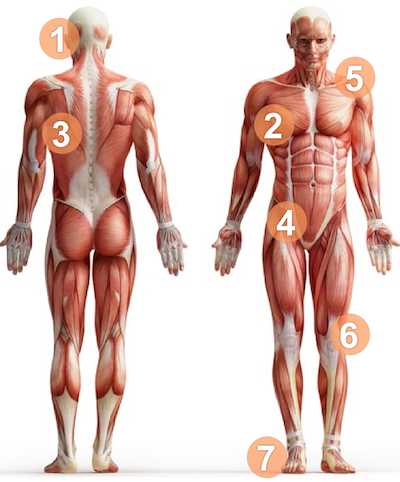Over time, your poor posture takes a tremendous toll on your spine, shoulders, hips, and knees. In fact, it can cause a cascade of structural flaws that result in acute problems, such as joint pain throughout your body, reduced flexibility, and compromised muscles, all of which can limit your ability to burn fat and build strength.
But don’t worry—all these problems can be corrected. Are you ready to straighten yourself out? Use this head-to-toe guide to make sure your posture is picture-perfect.
Analyze Your Postural Alignment
Have a Professional analyze your form while performing the OverHead Squat Test(visit your assessment tab within your MBS profile), or strip down to a pair of shorts and ask a friend to take two full-body photos, one from the front and one from the side. Keep your muscles relaxed but stand as tall as you can, with your feet hip-width apart. Now compare your photos with the illustrations below to diagnose your posture problems. Then see the following repair plans.
Assessment — Approach
Forward Head
Pain Areas: Your neck
The problem: Stiff muscles in the back of your neck
Fix it: Stretch with head nods daily: Moving only your head, drop your chin down and in toward your neck while stretching the back of your neck. Hold for a 5 count; do this 10 times.
The problem: Weak front neck muscles
Fix it: Do this neck “crunch” every day: Lying faceup on the floor, lift your head so it just clears the floor. Raise your head, and hold for 5 seconds; do 2 or 3 sets of 12 reps daily.
Elevated Shoulders
Pain Areas: Neck and shoulders
The problem: Your trapezius (the muscle that starts at the back of your neck and runs across your upper back) is shortened.
Fix it: Perform an upper-trap stretch. With your higher-side arm behind your back, tilt your head away from your elevated side until you feel the stretch in your upper trapezius. Apply slight pressure with your free hand on your stretched muscle. Hold for 30 seconds; repeat 3 times.
The problem: A weak serratus anterior, the muscle just under your pecs running from your upper ribs to your shoulder blades
Fix it: Try chair shrugs. Sit upright in a chair with your hands next to your hips, palms down on the seat, and keep your arms straight. Without moving your arms, push down on the chair until your hips lift off the seat and your torso rises. Hold for 5 seconds. That’s 1 rep; do 2 or 3 sets of 12 reps daily.
Rounded Shoulders
Pain Areas: Neck, shoulder, or back
The problem: Tight pectoral muscles
Fix it: Try a simple doorway stretch: Place your arm against a doorjamb in the high-five position (that is, forming an L), your elbow bent 90 degrees. Step through the doorway until you feel the stretch in your chest and the front of your shoulders. Hold for 30 seconds. That’s 1 set; do a total of 4 daily.
The problem: Weakness in the middle and lower parts of your trapezius
Fix it: Use the floor L raise: Lying facedown on the floor, place each arm at a 90-degree angle in the high-five position. Without changing your elbow angle, raise both arms by pulling your shoulders back and squeezing your shoulder blades together. Hold for 5 seconds; do 2 or 3 sets of 12 reps daily.
Rounded Back
Pain Areas: Neck, shoulder, back
The problem: Poor upper-back mobility
Fix it: Lie faceup on a foam roller placed about midback, perpendicular to your spine. Place your hands behind your head and arch your upper back over the roller 5 times. Adjust the roller and repeat for each segment of your upper back.
The problem: Weak muscles in your back
Fix it: Perform the prone cobra. Lie facedown with your arms at your sides, palms down. Lift your chest and hands slightly off the floor, and squeeze your shoulder blades together while keeping your chin down. Hold for 5 seconds; do 2 or 3 sets of 12 reps daily.
Anterior Pelvic Tilt
Pain Areas: Lower back (because of the more pronounced arch in your lumbar spine). The tilt also shifts your posture so that your stomach pushes outward, even if you don’t have an ounce of belly fat.
The problem: Your hip flexors, which allow you to move your thighs up to your abdomen, are tight.
Fix it: Kneel on one knee and perform a front hip stretch. Tighten your gluteal (butt) muscles on your kneeling side until you feel the front of your hip stretching comfortably. Reach upward with the arm that’s on your kneeling side, and stretch in the opposite direction. Hold this position for a count of 30 seconds, and repeat 3 times.
The problem: Weak glutes
Fix it: The glute bridge is your solution. Lie on your back with your knees bent about 90 degrees. Squeeze your glutes together and push your hips upward until your body is straight from knees to shoulders. Hold for 5 seconds; complete 2 or 3 sets of 12 reps daily.
Pigeon Toes
Pain Areas: Knee, hip, or lower back
The problem: Tightness in the outer portion of your thigh (your tensor fasciae latae)
Fix it: Stand up, cross your affected leg behind the other, and lean away from the affected side until you feel your hip stretching comfortably. Hold for 30 seconds. Repeat 3 times.
The problem: Weak gluteus maximus and medius muscles
Fix it: Use an exercise called the side-lying clamshell. Lie on one side with your knees bent 90 degrees and your heels together. Keeping your hips still, raise your top knee upward, separating your knees like a clamshell. Pause for 5 seconds; lower your knee to the starting position. Perform 2 or 3 sets of 12 reps daily.
Duck Feet
Pain Areas: Hip or lower back
The problem: You lack flexibility in all the muscles in your hips.
Fix it: Drop to your hands and knees and place one foot behind the opposite knee. Making sure you keep your spine naturally arched, shift your weight backward and allow your hips to bend until you feel the stretch. Hold the stretch for 30 seconds, repeat 3 times, and then switch sides.
The problem: Weakness in your oblique muscles and hip flexors
Fix it: Try the Swiss-ball jackknife. Assume the top of a pushup position but rest your feet on a Swiss ball. Without rounding your lower back, tuck your knees under your torso by rolling the ball with your feet toward your body. Roll the ball back to the starting position. Do 2 or 3 sets of 12 reps daily.
A treatment approach that has been clinically effective involves stretching of over active/tight muscles, strengthening of under active/weak muscles, and utilization of exercises that incorporate functional movement patterns last.










